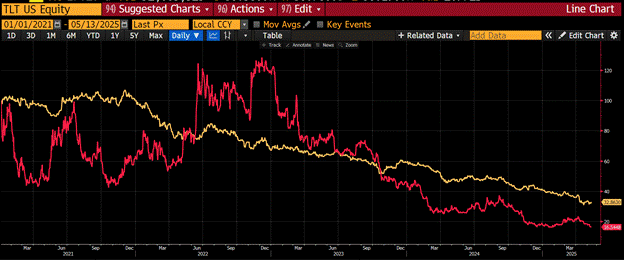Renowned industry commentator Arthur Hayes projects that Bitcoin could surge exponentially by 2028 due to capital flight and weakening U.S. Treasuries.
This prediction comes when Bitcoin has exhibited notable resilience over the past week, fluctuating between $101,500 and $105,800. Despite volatile intraday swings, the asset has maintained upward momentum, reaching $103,965 today.
However, price fluctuations have taken a backseat to broader structural conversations, as prominent analysts lay out projections.
Capital Flight Fueling a Rapid Price Ascent
Arthur Hayes, co-founder of BitMEX, projects that Bitcoin could climb to $1 million by 2028. Bitcoin would surge approximately 861.76% from $103,979 to $1,000,000. Additionally, the market cap would be approximately $19.86 trillion.
Hayes attributes this potential rise to the accelerating breakdown of global financial integration, especially between the U.S. and China. As capital controls become more common, he anticipates investors shifting from traditional financial instruments like U.S. Treasuries to decentralized hard assets like Bitcoin.
He further argues that Bitcoin’s status as a bearer asset gives it an advantage over gold in cross-border transfers. Unlike gold, which requires intermediaries and is limited by regulations, Bitcoin can move without centralized oversight.
Hayes also cites China’s OTC markets as evidence of Bitcoin’s resilience, noting that despite strict exchange bans, liquidity remains high. He believes similar underground liquidity channels would emerge in other jurisdictions facing capital restrictions, including the European Union.
Market Mechanics Could Accelerate the Price Climb
Hayes points to the potential for market dynamics to further accelerate Bitcoin’s rise. With foreign portfolio assets valued at $33 trillion, even a 10% reallocation—roughly $3.3 trillion—could overwhelm current exchange liquidity.
Since only $300 billion worth of Bitcoin is currently held on exchanges, such a shift could trigger a disproportionate price reaction.
In support, he shares a comparative analysis of the TLT ETF priced in gold and Bitcoin. Since 2021, U.S. Treasuries have lost 64% of their value in gold terms and 84% in Bitcoin terms.
Hayes believes this trend reflects a broader devaluation of Treasuries, further incentivizing capital migration to decentralized alternatives. Notably, he adds that nominal Treasury values are preserved, but their purchasing power continues to erode, particularly since post-2008 monetary expansion and COVID-era fiscal stimulus.
2028 Election Seen as Key Inflection Point
Meanwhile, Hayes identifies the 2028 U.S. presidential election as a critical inflection point. The election could usher in a new economic direction, depending on the political leadership and policies.
According to Hayes, future economic and fiscal strategies will heavily influence the flow of global capital. As such, he places Bitcoin’s trajectory toward $1 million within the context of political change and shifting macroeconomic fundamentals.
In essence, Hayes sees foreign capital repatriation, the devaluation of U.S. Treasuries, and the 2028 U.S. election as the three primary catalysts behind his $1 million Bitcoin projection before the end of the decade.
Supporting the $1 Million Thesis
Meanwhile, Binance co-founder CZ has echoed a similar outlook, stating during a RugRadio podcast that Bitcoin could hit $500,000 to $1 million. His view follows earlier public comments and a February tweet, where he suggested Bitcoin would rise to seven figures before correcting. CZ now believes the ongoing bull market could extend beyond 2025 and drive the broader crypto market toward a $5 trillion valuation.
Additionally, United States Senator Cynthia Lummis introduced a proposal calling for the U.S. government to acquire one million BTC—5% of the total supply—over five years.
Attorney Zack Shapiro argues that if implemented, such an initiative would trigger a substantial price rally to $1 million. This proposal, he claims, would be funded by the revaluation of U.S. gold reserves, potentially creating a new financial precedent.
DisClamier: This content is informational and should not be considered financial advice. The views expressed in this article may include the author’s personal opinions and do not reflect The Crypto Basic opinion. Readers are encouraged to do thorough research before making any investment decisions. The Crypto Basic is not responsible for any financial losses.





